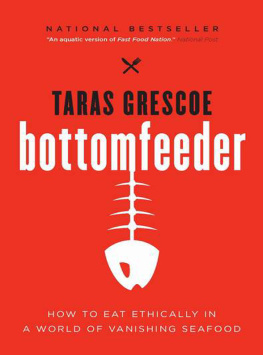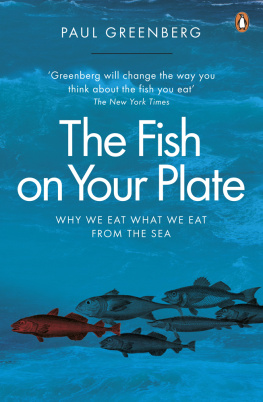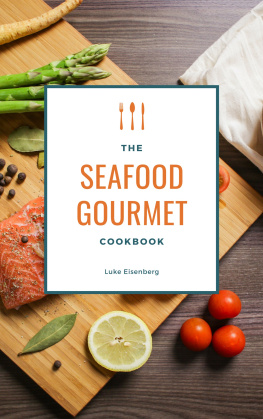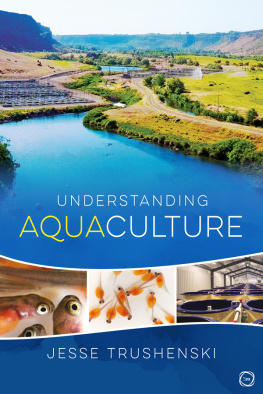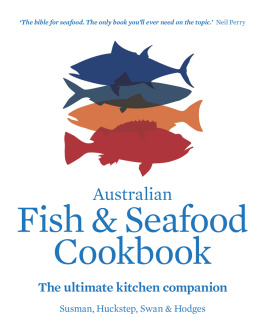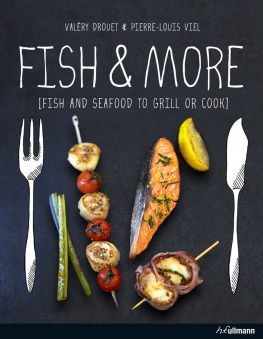BOTTOMFEEDER
How to Eat Ethically in a World
of Vanishing Seafood
TARAS GRESCOE

Contents
NEW YORK CITYPan-Roasted Monkfish
CHESAPEAKE BAY AND BRITTANYOysters
ENGLANDFish and Chips
MARSEILLESBouillabaisse
PORTUGAL AND FRANCESardines
INDIAShrimp Curry
CHINAShark Fin Soup
JAPANBluefin Tuna Sashimi
BRITISH COLUMBIAGrilled Salmon
NOVA SCOTIAFish Sticks
To Erin
Combines some literal seabed muckraking with a fascinating travelogue [An] aquatic The Omnivores Dilemma.
Gothamist
Grescoe takes us on an international tour of controversial cuisines meanwhile offering an overview of the corrupt practices that have put the oceans (and our health) in danger. The portrait he paints is grim: oceanic dead zones that, because of pollution and overfishing, can no longer support organic life; salmon farms polluted by pesticides and disease; ruthless bottom trawlers with nets that can destroy entire ecosystems. A warning is not a death sentence, however. The book empowers consumers to ask the right questions And asking these questions will make it possible to enjoy seafood for years to come.
Salon
Grescoes tale hits all the right notes. Its an entree youll remember.
Fortune Small Business
Every page of this book had me reaching for pen and paper to record yet another horrifying statistic about the way humanity is plundering the seas. This is not merely an entertaining treatment of a vital issue, it is an important book that anyone who thinks they care about the environment must read.
Guardian (UK)
Fascinating Will inform many about the dire state of the oceans, expose the dreadful environmental consequences of badly managed aquaculture, and prompt us to make better seafood choices With clear, compelling writing, Grescoe covers a vast array of topics ranging from ecology [to] cooking and eating, economics and history.
Ethicurean
Bottomfeeder highlights the diversity, complexity, and fragility of our oceans. Its an important reminder that we all have to take better care of our oceans if we want seafood in our future.
David Suzuki, co-founder, David Suzuki Foundation
Its a big mess and Grescoe charts it with muscular prose and a well-stamped passport Fired by a foodies passion for the animals whose disappearance he mourns.
Observer (UK)
In this whirlwind, worldwide tour of fisheries, Grescoe whiplashes readers from ecological devastation to edible ecstasy and back again.
Publishers Weekly
FOR THOSE WHO like to believe some things will never change, it must be good to know that places like Hubbards still exist.
On the road west from Halifax, you know you are getting close when you see the sign for the Shore Club, Nova Scotias Last Great Dance Hall, which has been serving two-pound lobsters and fresh berry shortcake since the end of the Second World War. Along the side of the road, fishermen sell discount scallops and solomon gundy, the local version of pickled herring, from the back of beat-up vans. Between the seaside rocks and the tiers of pine trees, black-roofed bungalows face the waves, many of them lobstermens homes now turned into summer cottages for city dwellers.
St. Margarets Bay, on which Hubbards sits, is a notch cut into the granite barrens of Nova Scotias south shore, filled to the rim twice daily with a generous cupful of Atlantic. This morning, the bay is socked in with fog, but the sun is already punching holes through the scrim of gray, making the plastic buoys and wooden dories on the water appear to glow from within. Standing on the deck of the Vicki & Laura, Lorne Harnish turns the wheel of his thirty-two-foot lobster boat, circling hard toward a wooden buoy attached by a rope to a trap at the bottom of the bay.
Cutting the motor, Harnish grabs a long gaffing pole, hooks the rope out of the water with a quick twist of his wrists, and threads it over a hubcap-sized pulley; a hydraulic winch rapidly pulls the ninety-pound trap to the surface. A semicylinder of bent oak roofed with maple slats and walled by netting, the trap looks like a miniature Quonset hut. Inside, four brownish-green lobsters cling to its seaweed-covered mesh. Harnish detaches one with difficultyit raises its claws in challenge, like a boxer facing a foe. After using a metal gauge to measure its carapace, he throws it into a plastic tub. The rest are shorts, too small to keep, and get tossed back into the water.
Though the lobsters are coming up undersized this late in the season, all in all it has been a good year for the lobster industry. Back in December, Harnish was catching half a tonne a day and selling them for $7 a pound to the local lobster pound. At the Halifax airport duty-free, two-pound lobsters, conveniently boxed for carry-on, are selling for $27.98.
By now the fog has burned away and St. Margarets, in all her ill-punctuated beauty, has revealed herself, the deep blue of the surface pixelated with thousands of fluorescent-hued buoys, each corresponding to a sunken lobster trap. All told, ten boats profitably work this tiny bay. For the last decade, from the Irish Sea to the Scotian Shelf, the lobstermen of the North Atlantic have been experiencing boom times. In the Gulf of Maine alone, southwest of Nova Scotia, there are thought to be three million traps in the water. When Lorne Harnish started fishing in the early 1970s, there were barely enough lobsters in the bay to keep him going for a week. Now he can haul up seven thousand pounds, in a season that lasts a full five months. Harnish, who has just turned fifty-seven, says he has no plans of retiring.
Harnish figures the lobster boom has something to do with whores eggs, local slang for sea urchins. Thirty-five years ago the bay was full of them. In the Gulf of Maine the urchins disappeared when they were harvested for their roe for the Japanese market; here, Harnish believes, they simply gnawed through the kelp, eating themselves out of house and home. Once the sea urchins were gone, the kelp returned, providing shelter and hunting grounds for the lobsters, who flourished in their turn.
Ecologists have another explanation for the boom. The shallow waters off Nova Scotia used to be full of swordfish and bluefin tuna, as well as untold numbers of hake, halibut, and haddock. Cod in particular were the apex predators in these parts. They prowled the gullies offshore in dense shoals, using their powerful mouths to suck up free-swimming lobster larvae, sea urchins, and even full-grown crustaceans. But the cod were fished to collapse in the early 1990s. With the cod gone, stocks of lobsters and other low-in-the-food-chain species exploded. It is a story that has been repeated throughout the Atlantic: with top predators fished to a fraction of their former abundance, it has become an ocean increasingly populated by shrimp, lobster, crabs, and other resilient, fast-growing crustaceans. An ocean, in other words, of bottomfeeders.
Harnishs day continues: he gaffs a rope, hauls up and empties the trap, fills the wire bait box with rotten mackerel, drops the trap, then moves on to the next buoy, until all 130 traps have been cleared out and rebaited. For the cottagers relaxing on lawn chairs on the shoreperhaps looking up from a headline about another ice shelf collapsing in the Antarcticthe sight of the


